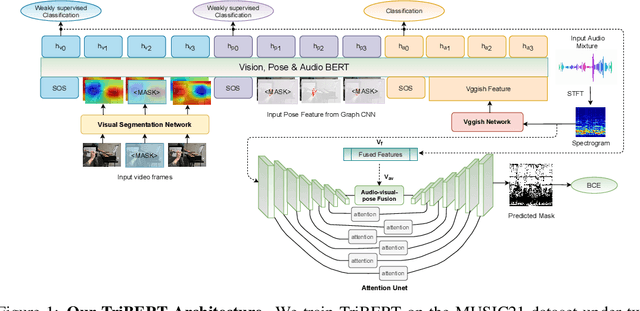TriBERT: Full-body Human-centric Audio-visual Representation Learning for Visual Sound Separation
Paper and Code
Oct 26, 2021



The recent success of transformer models in language, such as BERT, has motivated the use of such architectures for multi-modal feature learning and tasks. However, most multi-modal variants (e.g., ViLBERT) have limited themselves to visual-linguistic data. Relatively few have explored its use in audio-visual modalities, and none, to our knowledge, illustrate them in the context of granular audio-visual detection or segmentation tasks such as sound source separation and localization. In this work, we introduce TriBERT -- a transformer-based architecture, inspired by ViLBERT, which enables contextual feature learning across three modalities: vision, pose, and audio, with the use of flexible co-attention. The use of pose keypoints is inspired by recent works that illustrate that such representations can significantly boost performance in many audio-visual scenarios where often one or more persons are responsible for the sound explicitly (e.g., talking) or implicitly (e.g., sound produced as a function of human manipulating an object). From a technical perspective, as part of the TriBERT architecture, we introduce a learned visual tokenization scheme based on spatial attention and leverage weak-supervision to allow granular cross-modal interactions for visual and pose modalities. Further, we supplement learning with sound-source separation loss formulated across all three streams. We pre-train our model on the large MUSIC21 dataset and demonstrate improved performance in audio-visual sound source separation on that dataset as well as other datasets through fine-tuning. In addition, we show that the learned TriBERT representations are generic and significantly improve performance on other audio-visual tasks such as cross-modal audio-visual-pose retrieval by as much as 66.7% in top-1 accuracy.
 Add to Chrome
Add to Chrome Add to Firefox
Add to Firefox Add to Edge
Add to Edge